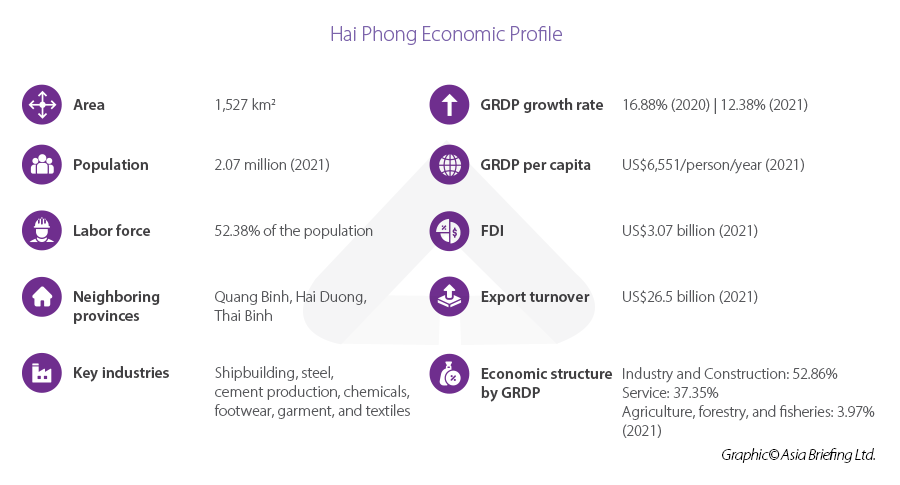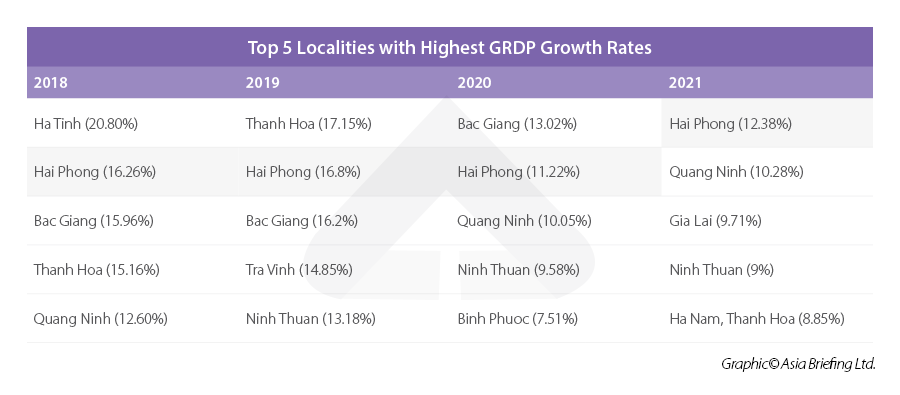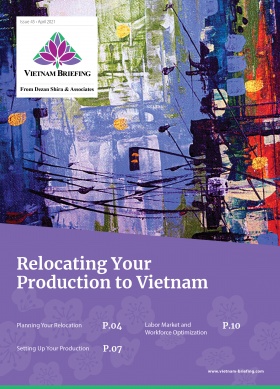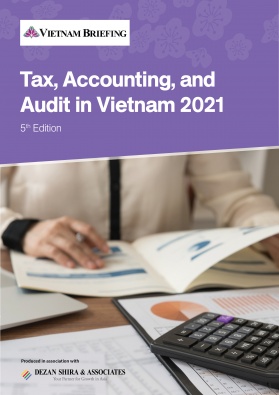Vietnam’s Hai Phong: An Industrial Gateway and Port City
- Hai Phong is the biggest port city of Northern Vietnam, the third-largest city after Ho Chi Minh and Hanoi, and one of the most important industrial hubs of the country.
- Over the past five years, Hai Phong was one of the fastest-growing cities in terms of GRDP across Vietnam.
- With an upgraded infrastructure system, a favorable geographical location in addition to the immense support from the government, Hai Phong carries significant potential for foreign investment opportunities.
Located about 120 kilometers east of the capital Hanoi, Hai Phong is not only the biggest coastal city in the northern region of Vietnam but also one of the major economic centers of the nation. It is among five municipalities of Vietnam, along with Hanoi, Ho Chi Minh City, Can Tho, and Da Nang. With an area of 1,527 square kilometers and a total population of 2.07 million people as of 2021, it is the seventh-most populated city in the country.
Strategically situated on the edge of the Red River Delta and with close proximity to the border with China, Hai Phong serves as a major trading hub. Being the only city in the North that has five modes of transportation, including railways, roadways, airways, inland waterways, and maritime, Hai Phong has the potential to develop into a center of large-scale manufacturing, industrial parks, and economic zones across Southeast Asia.
Hai Phong statistics
In recent years, Hai Phong has managed to maintain its position among the top two fastest gross regional domestic product (GRDP) growing localities in Vietnam. The average annual growth rate of Hai Phong in the 2017-2021 period was 15.26 percent, which is almost double that of the 2012-2016 period, and 2.9 times higher than the national average.
In 2021, Hai Phong ranked first nationwide in terms of GRDP growth rate, reaching approximately US$13.58 billion (current price), up 12.38 percent year on year. Despite having a low growth rate compared to 2017-2019 in part due to the pandemic, the city was among the two localities in Vietnam that achieved a double-digit GRDP growth rate in 2021 (ahead of Quang Ninh with GRDP growth of 10.28 percent).
In the first half of 2022, Hai Phong’s GRDP continued to increase by 10.04 percent compared to 13.22 percent year-on-year.
Sector growth
The industry and construction section continue to grow the fastest at 19.04 percent in 2021. Compared to 2020, the construction sector grew by 7.43 percent, while the industry sector with a growth rate of 20.75 percent plays a vital role in the city’s economy.
The services sector increased by 5.13 percent. The agriculture, forestry, and fisheries sectors slightly increased by 1.49 percent.
Economic structure
Hai Phong’s economic structure continues to shift towards industrialization in the quest for economic development, in which the industry and services sectors’ share of the city’s GDP will be growing while the agriculture sector’s share will be declining.
As of 2021, the industry and construction sectors remained dominant, accounting for the highest share of 52.86 percent of the city’s GDP, followed by the services sector at 37.35 percent. The agriculture, forestry, and fisheries sectors only accounted for 3.97 percent.
Trade
Compared to the same period last year, Hai Phong’s total export turnover in 2021 is estimated at US$26.51 billion, up 23.99 percent year on year. Meanwhile, total import turnover in 2021 is estimated at US$25.77 billion, up 25.84 percent year on year.
Infrastructure
In addition, the local authorities are stepping up the city’s infrastructure system. According to the People’s Committee Chairman of the city, Hai Phong plans to build another 100 bridges with a total investment of US$3.6 billion. Hai Phong’s Lach Huyen port – the largest deep-sea port in Northern Vietnam will also be expanded with the construction of Terminal 5 and 6. Upon completion, the two terminals are expected to be able to receive vessels of 100,000DWT, facilitating shipments from Northern Vietnam directly to the EU and the US markets.
The Hanoi – Hai Phong Expressway and Hai Phong – Ha Long Expressway are parts of a series of important regional infrastructure projects. Once the Van Don – Mong Cai Expressway’s construction in Quang Ninh is completed, it will create the longest highway in Vietnam, linking all major economic centers, industrial zones, and international airports in the North, including Noi Bai (Hanoi) – Cat Bi (Hai Phong) and Van Don (Quang Ninh), all the way up to Mong Cai international border gate. This will bring down the time and thereby the cost of transportation, fostering cross-border trade between Vietnam and China and other ASEAN countries.
Foreign direct investment
FDI figures and performance
According to the Ministry of Planning and Investment (MPI), as of 2022, Hai Phong was the sixth-largest recipient of FDI in Vietnam with a total registered investment capital of US$24.15 billion. As of January 2022, the city has 12 industrial parks in operation, in which there were 420 FDI projects by foreign investors coming from 36 countries and territories. Most investors are from Japan, South Korea, China, the EU, the US, and Taiwan.
Some major projects include the LG Display project from South Korea (worth US$5.84 billion), the Bridgestone tire plant from Japan (worth US$1.2 billion), and Microsoft and Apple assembly partner – Pegatron electronics manufacturing plant from Taiwan (worth US$481 million).
As reported by the Hai Phong Economic Zone Authority (HEZA), the FDI projects in Hai Phong industrial parks and zones account for more than 60 percent of the city’s industrial production and more than 70 percent of its export turnover.
In 2022, Hai Phong aims to achieve between US$2.5 – 3 billion in FDI, stated by the Head of the management board of HEZA. In the first five months of 2022, the total value of newly registered capital from 30 new projects, adjusted capital from 19 existing projects, and capital contribution or share purchase by foreign investors in Hai Phong reached US$832.72 million. This made up 33.5 percent of 2022’s goal.
The majority of new foreign capital is invested in the manufacturing and processing industry.
Following Resolution No.45-NQ/TW focusing on the economic development of Hai Phong City for the 2021-2025 period, the authorities encourage foreign investments in the high-tech industry, seaports-logistics, and tourism-commerce as the three pillars of Hai Phong’s economy. HEZA also aims to build 15 more new industrial parks with a total area of 6,418 hectares, in preparation for the new wave of foreign investment opportunities.
Government incentives in Dinh Vu – Cat Hai Economic Zone
The Dinh Vu – Cat Hai Economic Zone is one of the major coastal economic zones in Vietnam and is currently home to eight industrial zones in Hai Phong. Under the current law, Dinh Vu – Cat Hoi enjoys many investment incentives:
- Corporate Income Tax:
-
- Incentive tax rate of 10 percent within 15 years (calculated from the first year the enterprise has revenue from new investment projects); and
- Tax exemption for 4 years, and reduction of 50 percent for the next 9 years (calculated from the date of taxable income from the new investment projects);
- Personal income tax: reduction of 50 percent for those who directly work in the economic zone; and
- Import-export tax, value-added tax, special consumption tax: tax exemption in non-tariff zones.
Hai Phong as a China+1 location
With such rapid development into a major manufacturing hub, Hai Phong is a strategic investment location for foreign investors considering supplementing their manufacturing operations based on the China plus one strategy. Investors can choose to set up alternate production facilities in another competitive market such as Vietnam for supply chain diversification. In May 2020, Germany’s Tesa, an industrial adhesive tape manufacturer, confirmed to invest US$55 million into Haiphong following the China plus one model and reiterating Hai Phong as a manufacturing base.
In 2020, Hai Phong ranked 2nd out of 63 provinces in Vietnam, in terms of provinces having the most favorable business environment, according to the 2021 Provincial Competitiveness Index (PCI) assessment. The Index of Industrial Production (IPP) of Hai Phong in 2021 is estimated to increase by 18.15 percent year on year, which is among the highest growth rates of provinces and cities with large industrial-scale production in Vietnam.
With an advantageous geographical location, in addition to the infrastructure boost as well as numerous incentives to attract FDI from the authorities, the ongoing industrial development of Hai Phong will not only strengthen Vietnam’s connection with the global supply chain, but also make it one of the ideal locations for investors who are considering shifting their manufacturing operations and increase trade with the East and Southeast Asian countries.
About Us
Vietnam Briefing is produced by Dezan Shira & Associates. The firm assists foreign investors throughout Asia from offices across the world, including in Hanoi, Ho Chi Minh City, and Da Nang. Readers may write to vietnam@dezshira.com for more support on doing business in Vietnam.
We also maintain offices or have alliance partners assisting foreign investors in Indonesia, India, Singapore, The Philippines, Malaysia, Thailand, Italy, Germany, and the United States, in addition to practices in Bangladesh and Russia.
- Previous Article Impact of the Uyghur Forced Labor Prevention Act on Vietnam Exports to the US
- Next Article Vietnam Hit by Raw Material Shortages Disrupting Supply Chains: 7 Industries to Watch


































